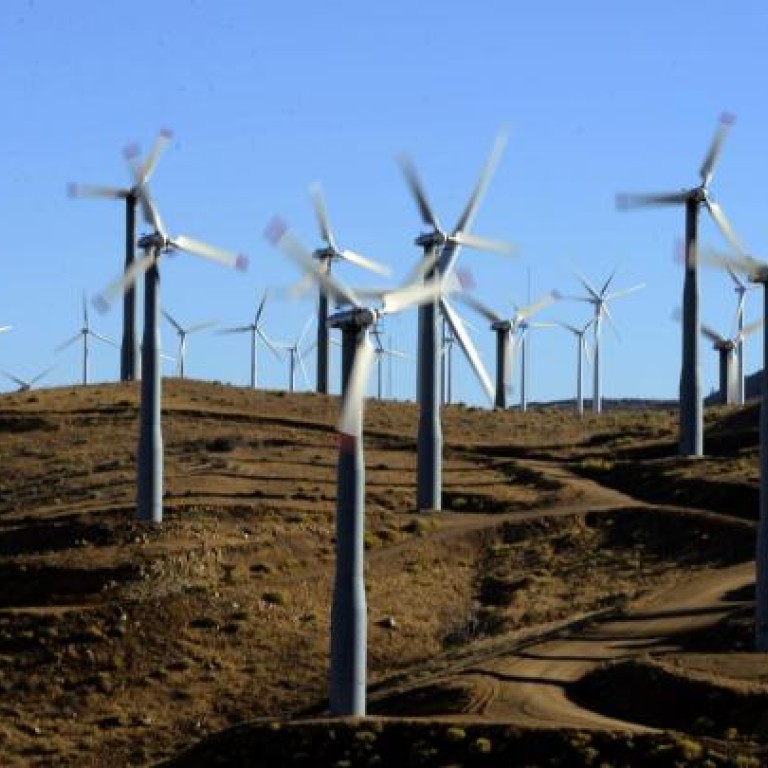
Mainland's wind potential blown away by power grid monopolies
The stranglehold of the operators means a reluctance to invest in the equipment needed to distribute renewable energy
The mainland's wind power generators will reach their full potential only if the state-owned power distribution giants lose their monopolies, said the China director of the Global Wind Energy Council.
This is because the grid operators are reluctant to invest in the hardware and software needed to meet the special requirements of intermittent renewable energy output like wind turbines.
The distributors preferred to rely on stable fossil-fuel power and regarded renewable energy as a troublesome animal, said Qiao Liming of the global industry association.
"Technology and funding are not the real issues. If there is a need, the grid companies have the means to make the necessary investment … It is more of a mindset problem," she said in an interview with the on the sidelines of the Asia Future Energy Forum.
About one-sixth of the power from wind farms in the north last year was wasted since it could not be delivered to consumers, the State Electricity Regulatory Commission said in a report in August.
This translated into a revenue loss of 6.6 billion yuan (HK$8.2 billion) when the farms were told by the grid operators to stop their turbines because the grid could not absorb their output.
This is only part of the industry's problem as it reflects only the poor performance of grid-connected wind farms. At the end of last year, 28 per cent of the nation's installed wind farms were not connected to the power grids, according to the commission, meaning a substantial portion of the wind farms had been idle.
The blame has been put on poor government control over the approval of new wind farm projects in the early years when there was a stampede to invest, and the failure of the distribution infrastructure to catch up.
State Grid Corporation, which owns and operates power grids in all but five southern provinces, blamed the poor equipment of wind farms for the many instances when their power had to be dropped from the grid.
The stoppages were to protect the whole grid from collapsing due to instability caused by the wind generators, State Gridsaid.
The corporation has since tightened the requirements on wind farm operators, but the bottleneck in grid transmission capacity is yet to improve.
This is partly caused by a delay in several large ultra-high-voltage power transmission projects that would send power from the remote energy-rich northern regions to the high-consumption coastal markets efficiently.
However, Qiao said a more fundamental issue was the insufficient research and investment by grid operators on their infrastructure to cater for the special needs of renewable energy.
"The bigger underlying problems are a lack of progress in electricity market reform and competition in the transmission and distribution sector. These have limited the drive for change and improvement," Qiao said.
Beijing separated the power industry's generation operation from the transmission and distribution section by breaking down the behemoth State Power Corporation a decade ago.
It has fostered competition on the generation side by forming five big generation companies.
However, transmission and distribution is carried out by State Grid and China Southern Power Grid, both monopolies in their respective regions.
Industry watchers have called for the break-up of the distribution business into several companies to create more competition, but there has been no progress. The proposals suggested leaving transmission operation as a monopoly to avoid infrastructure duplication.
With sharp falls in wind turbine prices in the past few years, the cost to produce wind power would be comparable to that of coal-fired power, had the market price of coal been fully accounted for, Qiao said.
During periods of sharp increases in coal price since 2004, Beijing has intervened and artificially kept prices lower than what the market was charging to protect the bottom lines of the power companies.
Coal-fired power prices have also been artificially kept low to help tame inflation.
Qiao said it was hard to tell whether the new leadership set to take over in March would be able to muster the political courage to push further reform of the power industry, given resistance from the grid monopolies.
